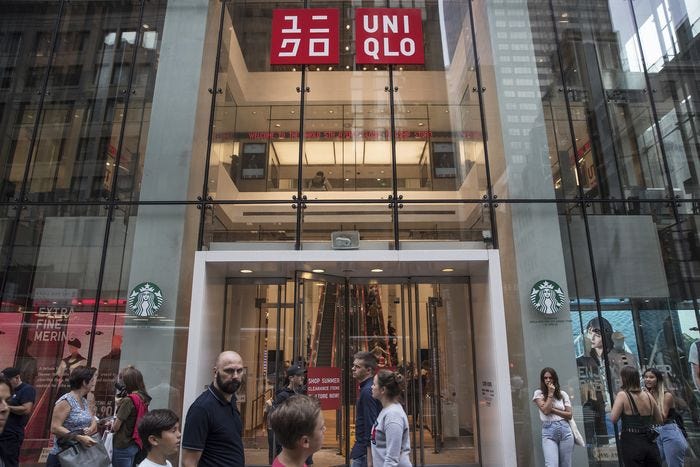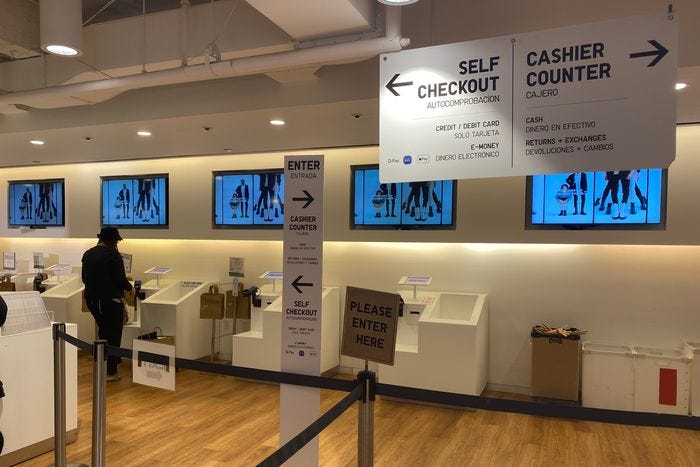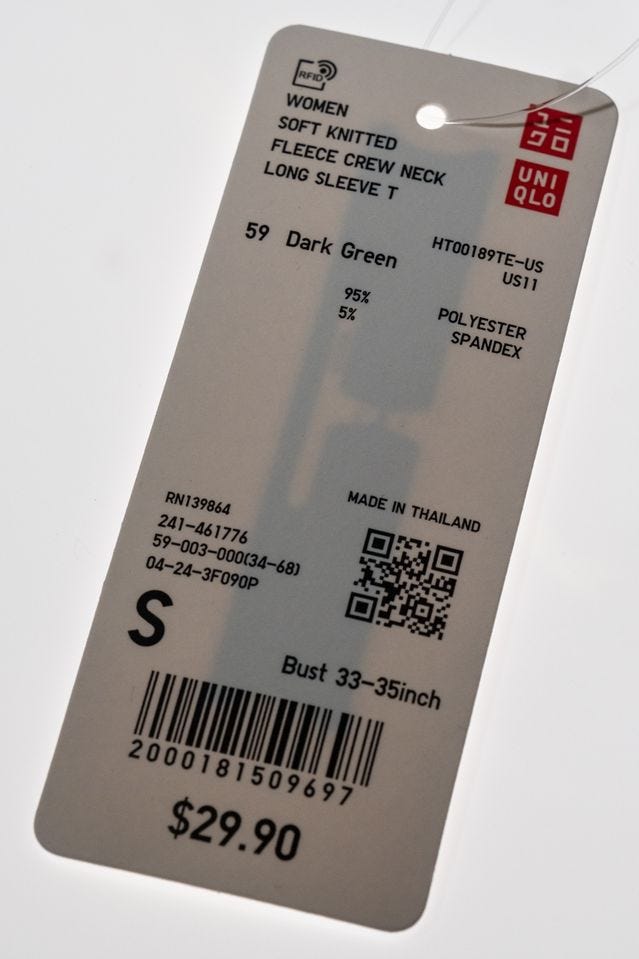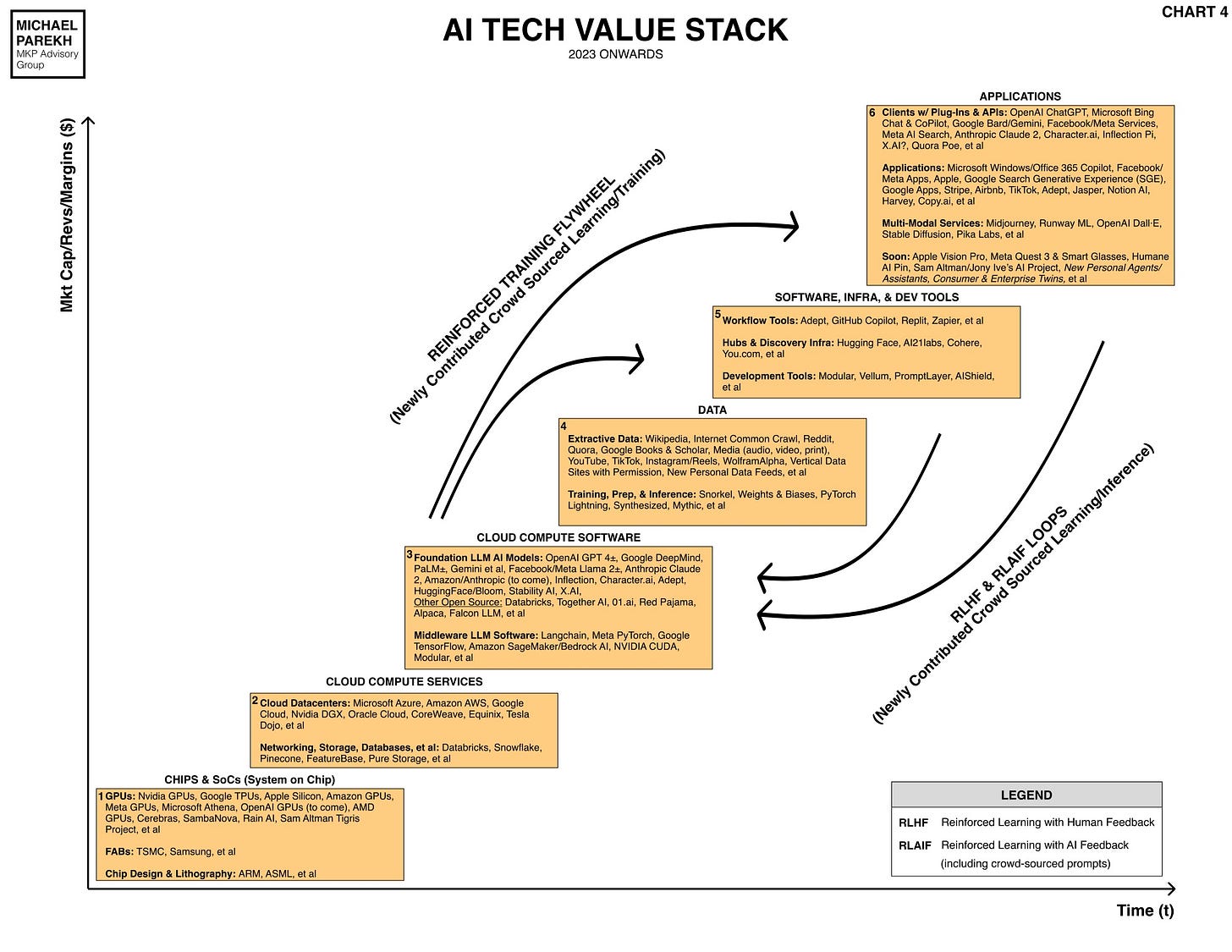The Bigger Picture, Sunday December 17, 2023
Sometimes, it’s important to remind ourselves that technology, even something as ‘dazzling’ as LLM AI powered ChatGPT, is a barely functional early tool. Not only a tool, a beginning step on the long stairway to SLOWLY make a range of disparate technologies useful to society. Empowering them, freeing them of more tedious tasks and move up the staircase of work to more productive tasks. The fashionable words are ‘AI Augmentation’. And I’ve described many times, it most times takes longer than expected.
In this Sunday’s ‘Bigger Picture’, I want to focus on how Uniqlo, a part of Japan’s Fast Retailing Co., and Asia’s largest retailer, did something amazing with an old technology to do something truly new. And it took a while.
They transformed a humble technology, RFID (radio frequency identification.originating back in 1945). The underlying technologies here as we recognize them in retailing, were invented in a series of innovations in 1973 (fifty years ago). Countless retailers use these technologies already. But it was Uniqlo that uniquely deployed a version of this tech into a service that ‘dazzles’. While you buy socks on their flagship store on Fifth Avenue, or dozens of other Uniqlo stores around the world.
It has nothing to do with the AI Tech Wave per se, the subject of this site, but it has everything to do with older Tech waves that will eventually affordably incorporate AI (in the form of computer vision someday). Those applications are already being experimented on with robots and other LLM AI applications by Google, and others today.
But this story with the humbler RFID technologies, is a great case study on understanding how long technologies take to sometimes really do cool things. And AI is but just a series of steps on that long climb up. Let me explain.
Here is the setup from the WSJ’s “The Self-Checkout even the Haters will Love”:
“Every so often a technological breakthrough comes along that makes you feel like you’ve teleported to the future: the iPhone, ChatGPT, self-driving cars.”
“And self-checkout at Uniqlo.”
“Really! One of the craziest things you can do these days is buy socks. Just walk into a bricks-and-mortar store, pull clothes off the shelf and drop them in a bin. What happens next will seem like magic.”
“I recently had this experience at the Uniqlo flagship on Fifth Avenue in New York, a three-level store packed with holiday shoppers. On the top floor were two options. To the right was the service counter. To the left was self-checkout. I went left.”
“I picked one of the dozen self-checkout machines, followed the instructions on the screen and placed my clothing in the box.”
“The machine did the rest of the work. I confirmed the number of scanned items, tapped to pay and grabbed my receipt. And that was it. The whole thing took 30 seconds. The escalator ride downstairs took 40 seconds.”
The key sentence above is ‘The Machine did the rest of the Work’. Most self-checkout systems at retailers today, force the customer to manually scan each item. Tediously doing the labor that the store would otherwise pays employees to do. It’s why self-checkout technologies to date have not taken off despite serious effort and investment by the industry. It’s mostly tech for tech sake. Uniqlo’s solution is not about the labor costs. It’s about how the technology frees up both the customer and employees from mundane tasks altogether.
As the article explains in detail, well worth reading in whole, the long journey was a labor of love for Uniqlo’s parent company Fast Retailing’s Chief Information Officer (CIO) Takahiro Tambara.
And they could only do it since they controlled the whole supply chain from the factories to the retail store checkout. It took years to perfect:
“Tambara became obsessed with creating a better, faster self-checkout because of the company’s mission to “wow the customer,” as he likes to say. He thought there could be something dazzling about paying for socks.”
“At most stores, the self-checkout line has the appeal of wet socks. But this one has become so popular that it’s used by 70% of Uniqlo’s customers, including 90% in some markets. It sounds dystopian, but it’s actually delightful. People love it so much they forget how much they hate self-checkout.”
“So what’s the magic behind this brain-melting automated process? As it turns out, it’s surprisingly primitive tech. The self-checkout machines use radio frequency identification readers to automatically detect RFID chips hidden in the price tags of Uniqlo’s products.”
“Those invisible chips have become indispensable to a company that sells a billion pieces of clothing a year in thousands of stores around the world. “
Tambara and his team re-thought the technologies at scale, both their capabilities and cost over time:
“The key to the whole operation was RFID tags, as my colleague Belle Lin explained in this article.
“To be more specific, it was the economics of RFID tags. As the tech became more precise and less costly, with the price of a tag dropping to roughly 4 cents, give or take a penny, retailers could afford to buy RFID chips in bulk and deploy them in novel ways: predicting demand, adjusting production, optimizing distribution, preventing theft—and reinventing self-checkout.”
“Fast Retailing’s investment makes Uniqlo an outlier when retailers are closing their self-checkout lanes and kiosks to combat theft, shoplifting and lost inventory. But for grocery stores and big-box chains, Uniqlo’s self-checkout system is not just impractical. It’s essentially impossible. Fast Retailing pulled it off only because it controls the supply chain from the factory to the sales floor.”
“It wasn’t going to be cheap. Uniqlo would have to embed billions of these chips in the price tags of shirts, pants, underwear, outerwear, Heattech innerwear and every item of clothing for sale in every store. (There are four types of RFID tags: hanging tags, waist tags, sticker tags for packaged goods and header tags for those socks.) It also wasn’t going to be easy. “Imagining it is not difficult,” Tambara said. “Executing it is completely different.” When I asked him to name some of the challenges, he responded: “Yes.”
“The challenges of executing included selling the idea to Fast Retailing executives, factory managers, store employees and, of course, Uniqlo shoppers.”
The full piece and its accompanying piece on the RFID technology innovations are also worth reading.
The crux of the connection to AI is the following from the accompanying piece:
“While generative artificial intelligence and the viral chatbot ChatGPT have captured the world’s attention, there is still a lot of work that can be done with simpler technologies such as RFID, retail analysts say. RFID remains the most practical, if not the most advanced, technology for merchandise tracking, said Sucharita Kodali, a vice president and analyst focused on retail at Forrester Research Inc. Computer vision, a form of artificial intelligence that can analyze images, is still too expensive for widespread use for self-checkout and inventory management.”
What’s particularly remarkable about this story is that Fast Retailing and Uniqlo are not technology companies at their core. They’re retailers. And they’re not American. Big Tech Magnificent 7 companies like Amazon and others have spent extraordinary sums and time trying to make self-checkout stores work. And it failed for them. Amazon Go was a complicated example of why it didn’t work. Lots to read (recommended), and unpack here, but the key lessons are the following:
Self-checkout is not a technology, but a SET of technologies over time.
Cost of deployment at scale and over time matters.
Human engineering matters the most, and does not move at the speed of the enabling technologies.
Applying the technologies across the ecosystem, from factory to customer, makes the difference.
Many more reasons and lessons on why it didn’t work for the core tech companies. And a retail company made it work, nay, ‘dazzle’, with a set of technologies used differently, and with core re-engineering around humans and their behaviors.
AI is going to be the same. Vertical industries and companies with them are going to have to patiently and painstakingly figure out both the augmented and native AI apps that will make a difference for their customers and partners.
Contrary to general belief, AI is not a singular technology, LLM AI in particular. As Meta’s Chief AI Scientist Yann LeCun highlights, it’s a WHOLE HOST of technologies, both closed and particularly Open:
“Imagine a world without (Meta) PyTorch, and with enforced patents on Transformers, ResNet, Mask-RCNN, FPN, SAM, DINO, seq2seq, wav2vec, memory-augmented networks, Tansformers, BatchNorm, LayerNorm, Adam, denoising auto-encoder, joint-embedding architectures, and tons of SSL methods…”
It’s all that gnarly, in the deep weeds techie stuff in Boxes 1 through 5 in the AI Tech Wave chart below, before we get to the Holy Grail of cool AI applications and services in Box 6:
Everyone of those AI technologies are the critical components of how LLM AI and particularly, multimodal LLM AI currently works, in these early days of the AI Tech Wave. There’re so many AI technology components to come. It’s barely begun.
It’s why we can’t rush ahead to be either too optimistic OR pessimistic on what AI has in store for us. Especially not too fearful prematurely. There’s a lot of work to do to put it altogether right despite the exponential pace of the underlying AI model capabilities on ever more powerful AI hardware.
Sam Altman, the founder/CEO of OpenAI, which just celebrated the turbulent anniversary of its flagship ChatGPT product and service this November, said back this February that “ChatGPT is ‘cool’, but it’s a ‘horrible product’. The details there too are worth reading on where things stand today, and how far up we have to go.
Just like when RFID was introduced as a ‘cool’ retail checkout technology decades ago. It took a long time and substantial investments to get it to a point where it ‘dazzles at scale’.
The RFID case study illustrates how a wide range of technologies that originated all the way in 1945, got us to a point where we can checkout socks in a ‘dazzling’ way in 2023.
AI this year has seen a dramatic debut with OpenAI’s ChatGPT. And unlike many other technologies, it has been accompanied by unprecedented Fear than anticipation of the opportunities.
To me the RFID tag story illustrates not just how long it takes to get tech to do truly cool things, but that it’s just technology that can be used for more good than bad. Less to fear, more to tinker with and get right things that are truly useful and ‘dazzling’.
AI is on the same slow staircase of technological progress. Especially to the holy grail of ‘AGI’ aka ‘SuperIntelligence’. It’s going to be a long series of lots of steps, despite the exponential technical progress ahead in hardware and software.
Refining processes and addressing human nature always takes longer than we think.
Freeing us from doing tedious things to do less tedious and more rewarding things up the stairs. Even if it’s just about checking out faster with new socks. Stay tuned.
(NOTE: The discussions here are for information purposes only, and not meant as investment advice at any time. Thanks for joining us here).












